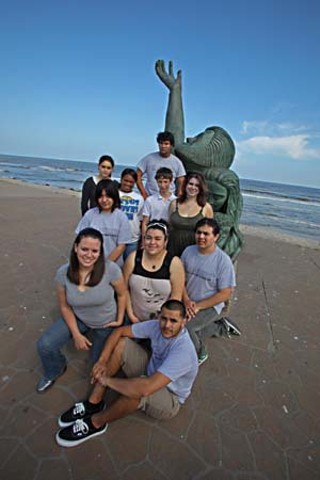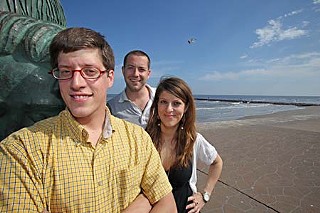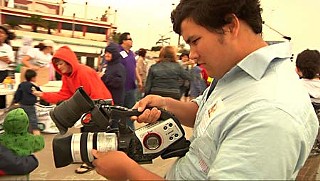When the Sun Rises
In the aftermath of Hurricane Ike, a group of teenage filmmakers galvanizes the tales of its island
By Kate X Messer, Fri., June 5, 2009

The lobby of the Grand 1894 Opera House came to life with young men scurrying backstage to change into suits and girls showing off ball gowns. The line to get in the theatre stretched around the block. Next door at Rudy & Paco, the see-and-be-seen crowd realized they'd better inhale that ceviche if they wanted to get a good seat:
The most exciting film premiere on Galveston Island – perhaps since Thomas Edison's guys shot that footage of the 1900 storm – was about ready to begin.
"My winds grew strong, my waves rose to heights I had never before achieved, and my people left."
You'll have to excuse the teachers and students of Galveston's Ball High School. Last September 11 wasn't spent commemorating the 2001 terrorist attacks. For them, terror was a hurricane as wide as the Gulf of Mexico – whose warm, shallow waters were being sucked up into the monster storm like Red Bull during finals week.
"We were all scared; my mom was eight months pregnant," remembers then-incoming freshman Melnikia Smith, whose concerns about attending a big, new school were suddenly put on hold. "We packed food, clothes, boarded up the windows, and had to get our family together so we could all leave at the same time" – a formidable task for Melnikia's family of 13.
As if the beginning of the school year isn't jittery enough for new and returning students. High school students are supposed to be preoccupied with stuff like football season, who's my BFF, and when is senior skip day? This year, however, the typical seemed trivial. Ball High officially closed that Thursday, as the island awaited the declaration of mandatory evacuation.
Melnikia now recalls the anxiety at having to leave their beloved home, which was so close to Ball High: "Are we going to be safe? Is our home going to be okay when we get back? How about the rest of our family and friends? And what about the baby?"
The projected trajectory of the ninth named storm of the hurricane season had even the most seasoned weather trackers scratching their heads. Initial guesstimates placed landfall on the northern Mexican shore, close to the border. As hours and then days passed, the forecast took on the characteristics of a minute hand ticking clockwise up a coastal clock. First Brownsville, then Padre, then the National Seashore, then Corpus, then Freeport. But a lot of people had a feeling about Galveston.
Then-senior Jennifer Willcut lives just north of the island in the small neighboring village of Bayou Vista. It's nestled against the northern shores of West Bay, with Technicolor sunsets and inlets that create fingers of waterfront property populated mostly by middle-class retirees, some families, and seasonal residents with beach houses – or, more accurately, bayou houses on stilts. "A lot of the Galveston mindset," says Jennifer, "was that Ike was going to be ... well, like Rita: that it was not going to hit us. A lot of people stayed; we thought we were invincible to hurricanes.
"My family – for a couple of days there – wasn't going to leave. But the day before the storm, we started getting that gut feeling," she says. As waters began to rise, they moved everything up from downstairs and prepared to head for Houston. "It was going to be much, much worse than anybody anticipated."
"The rain was falling in sheets. Hard, rocklike sheets determined to tear and rip at everything my people had made, to destroy the life we had made together."
"I worked all summer at Schlitterbahn, and I'd become really good friends with these exchange students from the Ukraine," says Ball High then-junior William Gomez, a burly and very independent young man who lives with his father. "They said they were going to stay for the storm."

"My dad had the smart sense to leave," says William. "I, on the other hand, didn't get off the island in time. Luckily, my friends were crazy enough to stay, too. Around midnight [12mid of Sept. 11], we went down to the Seawall, and the waves were unbelievable – above our heads and beyond. It was crazy. The next day, the water was too high; we had to vamoose it to Ball High."
The island's only high school had become the town's shelter of last resort. The kids in William's group were some of the first to arrive. But within a few hours, the cafeteria was packed. To add to the surreal experience of being stuck in one's own high school with a lot of destitute strangers, the power went out, and the first floor took on water, sending all evacuees upstairs.
Then things went really pear-shaped.
"I looked down the hall," William tells, "and I could see this glow. We walked down the hallway and see a whole block of houses on fire. The rain, the wind, just everything blowing. ... It looked like we were in the middle of the ocean."
"So that when the storm retreated – depressed in its failure at destroying us – we would have a place to return."
The sleek and looming edifice of the "new" Ball High School belies its mid-Fifties edification. (The original Ball High opened in 1884, the first public high school in Texas.) The main entrance of the four-square-block complex features a three-story bank of glass and Populuxe eaves – quite a contrast against the island's row upon row of Victorian 1900 storm survivors and Craftsman bungalows.
Ball High reopened to students on Oct. 7, 2008, almost a month after Hurricane Ike thrashed the island. The return to school provided a sense of normalcy post-Ike. It was time for the kids to reconnect and share stories with fellow friends who endured similar trauma. "It was all very helpful," Melnikia says of this sharing. "The first day we got back, we all sat in a circle and told our story. Most of us were crying because we lost our homes." What Hurricane Ike didn't blow over, the rising waters of the storm surge soaked or cleared away. Melnikia's family lost everything. Their house was uninhabitable, and they moved to the makeshift public shelter called Tent City until they could find a new home.
Jennifer and William – who both lost ground floors and many dear possessions to Ike – are both enrolled in Robert Weiss' advanced media technology class, a film-production and theory class for upper-level students. The affable Mr. Weiss, 26, could easily be mistaken for a student at Ball High. The native Galvestonian has a contagiously earnest air about him – like a young Ron Howard (but with hair). Weiss knew that many of his students would be shaken but that decisions must be made. Should they continue with the films begun before the storm?
"Jennifer tells the story about how when we got back, she was trying to find a way to forget everything that happened." Weiss laughs. "And then here I was, 'What do you guys think about making a documentary?'"
"We all knew we were going to do something about the hurricane," says William, "whether it was going to be a 10-minute video or a great [feature-length] movie, like it is now. Honestly, when we started, we thought this thing would just be on YouTube."
A number of students in Weiss' various art and film classes had stayed through the storm; some had even shot footage. Weiss recalls, "I told the students: 'If we start this, we are going to finish it. And it's not going to be easy. There will be days where you hear stories that make you not want to do it anymore, and we've got to stick through it.'"
The class unanimously agreed. The teacher's directives were clear: "You need to come back with two interviews by the end of the week."
Ike: A Documentary was born.
"So that when the roads were cleared and the buildings repaired, we could move on, restart from our lives before the storm, before the destruction and the pain and the desolation and the exhaustion and the apathy towards breathing and feeling ... and life."
"Instead of just telling my story," says Melnikia, "I wanted to see how everybody else felt about their story." So she checked out a camera to document her time at Tent City. "At first, most people didn't want to talk," she recalls. "They were a little shocked that we would start up a program like this. But then they just came up out of the blue and started telling their stories."
"School lets out at 3:30pm, and we stayed here until 7pm every day collecting interviews, editing, working on the timeline," says Weiss. "We'd go out right after school, walk as far as we could for 45 minutes, and then head back. Everybody we encountered on the streets was doing the same thing: throwing their stuff out, cleaning up. People would be in their gloves with mops in hand, and we'd ask, 'May we interview you?' A lot of the time, they'd say, 'We're too busy!'"
But when people began to open up, the stories flooded in like so much storm surge, saturating the kids with tales of loss and survival. William remembers how he felt hearing one such story. "We interviewed this woman who stayed at her house. The water came up to her head. She held a candle above water to keep her spirits up. After surviving all that, she couldn't find her dad. At one point in the interview she's going: 'Daddy? Daddy?' She wrote a message to him on the wall of the house. Then her dad was right there. 'There's Daddy!' It gave me a big piece of hope," William says.
"After a while, the interviews became completely different," remembers Jennifer. "Originally, I'd ask about insurance battles, water damage, construction. ... I don't really dwell on that anymore. Now I ask how it affected them personally. We're looking at people, not at the splinters, the nails, and the fallen houses. A lot of Galveston is run by small family businesses, mom-and-pop shops. I became aware of how the community had pulled together. Before, I was so focused my own losses. It's entirely shifted the scope of the project."
As the town grew accustomed to the students' presence and intentions, the group became known as the "Hurricane Story Tellers." "We'd be out on the street giving interviews, and people would honk because they'd know it's us," Jennifer grins. This literal street cred helped them move beyond folks-on-the-street interviews, scoring time with Galveston Mayor Lyda Ann Thomas, city father and developer George Mitchell, and broadcast news legend Dan Rather.
"Ike was a tale, a tale of my land, of my people's island, a tale we would tell for years to come, for it would show our prosperity, it would show our fortitude, and it would show everything we could become."
No matter what outer appearances to the contrary may imply, high school kids and their experiences resonate between generations more than most adults would care to admit. For the most part, today's kids like to blend in and, given the choice, would often prefer to remain invisible than to stick out from the crowd. The confidence they do show at this age is worn like a new pair of shoes, shiny, sometimes uncomfortable, and most often squeaky. They still mumble things such as: "ummmmmm," "like," "wow," "crazy," and "righteous." They still stop in the middle of interviews to ask if a word they just used is really a word.
But the Hurricane Story Tellers had no time to worry about their comfort zones. They were already wading hip-deep, confronting their own experiences while documenting the stories of strangers. It's only natural that the focus on a project like this would shift inward. Weiss remembers: "I saw that they were reading Chaucer, Canterbury Tales, and I asked them about it. 'Well, it's about these guys sitting around telling stories, and sometimes they were in the stories.'" During production, the class also made a point of not watching similarly themed documentaries, such as When the Levees Broke and Trouble the Water. "Just like in theatre: When you are playing a part, you shouldn't watch other versions of your character," say Weiss.
Melnikia's family was stuck in Tent City for more than a month. "It was a little weird living in a tent. We slept on cots," she says. Aside from helping her mom, there wasn't much to do except play outside. Some of the younger shelter kids looked up to the friendly high school freshman. "I just wanted to teach these girls some little dances I learned in dance class. You know, so that when they go back to school, they can teach other kids." Melnikia's sweet mentoring shows up in some of the film's footage. "We still stay in contact."
As the students' own stories began making their way into the documentary, it became important to stay true to their own voices. "It's not going to be interesting to people," says Jennifer, "if we're all a bunch of Rhodes Scholars.
"This is like my dream class," says Jennifer, letting the healing begin. "The happiest part of my days now is film class. Who gets to be 18 years old and make a full-length movie?
"It's really nice to see it all come to fruition. Is that a word: fruition?"
"Ike took my people and made them come together; it took my people and forced them to regroup, to become better, and to defy Mother Nature."
By early spring of this year, the doc began taking shape. Weiss had called in his sister, Broadway stage manager and documentary film producer Heather Weiss, and his cousin, New York documentary filmmaker (and former Austinite) Aaron Weiss, to join the team and "push the production side." The three have, since their youth, shared ideas and sensibilities and collaborated on one another's projects in varying degrees (including an exquisite video for White Denim through Robert Weiss' Modern Plow Collective). "This," however, according to Robert, "is the first time we've worked together as mentors and producers."
Aaron Weiss' parents connected them with Dan Rather (whose career, incidentally, owes much to his harrowing and historic coverage of 1961's Hurricane Carla along the Galveston Seawall). The crew drove up to Austin to meet Rather. Jennifer would conduct the interview.
"I'd known that he'd been there for a lot of groundbreaking news reporting, but I didn't know just exactly how much stuff he'd been there for: Tienanmen Square, Nixon. He became my idol," says the 18-year-old.
"I expected this tall, looming dude, but he's just a typical guy. He was in a polo and a windbreaker. He just walked over, shook all our hands, and learned our names. He looked me in the eye and has that voice that I like to describe as a 'chocolate lullaby.'"
"My inhabitants, like myself, would face their fears; they would go against everything they thought was true and prove that a storm was no ending."
Thursday, May 21, 2009. Galveston's Grand 1894 Opera House is packed to the rafters. After a few charmingly awkward puffs of the majestic velvet curtain, Jennifer emerges to introduce the film.
"Wow, thanks," she says. "You'll have to excuse me; I am very nervous." A round of applause and laughter breaks the tension. "We made this movie for Galveston, and I see, here she is!" After thank yous and applause, the lights dim, and the film begins. It's the hometown crowd, a hometown that lived through the same havoc as many of the kids behind the scenes and the interviewees on the screen.
Dan Rather sets the scene for outsiders: Galveston is not a "cookie-cutter community." There are all different social groups, races, classes. And the film takes over where he leaves off, shining a light on the people, places, and artifacts touched by Ike:
The woman who waded through waist-deep water to find her family only to find they weren't there.
The beloved owner of Luke's supermarket and deli, thought dead, alive and well, minus one leg.
The irreplaceable archives lost at the historic Rosenberg Library.
AIDS psychiatrist Dr. Eric Avery, citing concern for the layoffs at the island's major employer, the University of Texas Medical Branch.
The woman at Smitty's Bait House who had to hop from boat to boat to survive.
Melnikia, comforting the kids stuck in Tent City.
Student Mamie Aoughsten's powerful essay threaded through the documentary as well as through this article.
Then-freshman Christian Dierlam's encounter with strange green stuff.
The journalistic torch passed from Dan Rather to Jennifer Willcut.
A Mardi Gras celebration, set against the stark, ravaged emptiness of the Bolivar Peninsula.
The mason whose bagpipe rendition of "Amazing Grace" kept hope alive.
The woman underscoring her chalk statement: STILL WE RISE.
All captured by the big hearts of the Hurricane Story Tellers. With these testaments, the premiere of Ike: A Documentary: The Story of a Torn City Rebuilt by Everyday Heroes became a high-water mark in Galveston's ongoing healing process.
"Because when the sun rises, so do my people. Because when the sun rises, so does our future. Because when the sun rises, my tale is told."
The halls of Ball High School are abuzz with the same scenes familiar to every high school across the country. Spring is in full swing, and that means the end of the school year. Posters for yearbook sales and other year-end traditions dot bulletin boards throughout the maze of classrooms. The scene in Weiss' advanced media tech class is decidedly calm. A sense of relief fills the air. The premiere is over, and as for the kids? "The kids who were in my class working on the hurricane doc – this counts as their final exam," says their teacher. "Everybody got 100." (Weiss was named Ball High School Teacher of the Year.)
But the story does not end here. Outside interest in the documentary has been piqued, and a visit to New York is in the works. There will be film festivals and a DVD, with all proceeds donated to the Galveston Education Foundation. In the meantime, the Story Tellers will screen the film at KLRU's Austin City Limits studio on Friday, June 12.
And although many of the Story Tellers are graduating seniors, some are pledging continued commitment to the project. "I'll be in college next year," says Jennifer, who hopes to travel for any film festivals next year. "As long as this thing is going, I'm sticking with it. I worked too hard, and I believe in it too much to let it go."
It's a brand-new day on the island ... and just in time for hurricane season 2009. "We see this project as a way to give back to Galveston. It's not even a documentary anymore. It's something we've dedicated to the people," says Jennifer. In providing a forum for these local stories, the wise-beyond-their-years Hurricane Story Tellers have given voice to their own. Ike: A Documentary may not end up being the Ike documentary, but as a labor of love, it serves as testimonial not only to the everyday heroes mentioned in the title but to the curative power of film, art, and collaboration.
"This is the beginning for the Hurricane Story Tellers," says Jennifer. "This is not the end. Just the beginning."
Ike: A Documentary: The Story of a Torn City Rebuilt by Everyday Heroes screens at the Austin City Limits Studio 6A at KLRU, Friday, June 12, 6:30pm. Seating is limited. To attend, please RSVP to rsvp@ikedocumentary.com by June 11. Media contact: Lily Pollak, lily@ikedocumentary.com. Visit www.ikedocumentary.com for more info.
The prose text quoted throughout this story is excerpted from Ball High School student Mamie Aoughsten's narration/essay, "The Tales of an Island."












